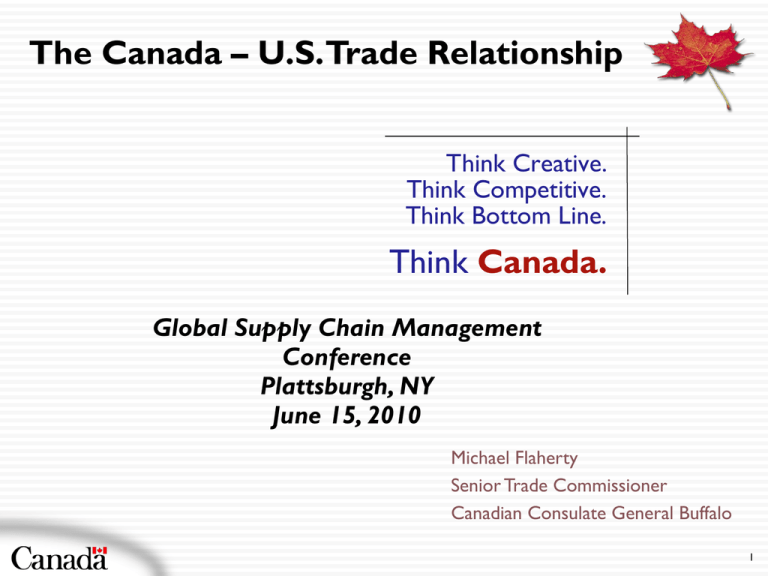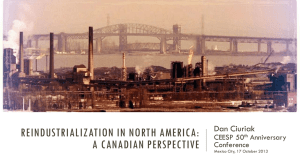The Canada - Global Supply Chain Management Conference
advertisement

The Canada – U.S.Trade Relationship Think Creative. Think Competitive. Think Bottom Line. Think Canada. Global Supply Chain Management Conference Plattsburgh, NY June 15, 2010 Michael Flaherty Senior Trade Commissioner Canadian Consulate General Buffalo 1 Canada has a Relatively Strong Economy Despite the Global Slowdown Real GDP Growth and Projections (%) 4.0 3.2 3.1 3.0 2010-11 1.8 1.9 1.7 1.6 % 2.0 1.0 0.8 1.0 0.7 0.7 0.5 0.3 0.0 Source: Consensus Forecasts, April 2010, Consensus Economics Inc. Japa any Germ Fran ce U.K. U.S. Can ada Italy -0.6 -1.0 2006-09 n -0.5 2 Canadian Response to Recession $13 Billion - Personal Tax Cuts +$21 Billion – Infrastructure Investment +$9 Billion – Housing Stimulus +$9 Billion – Business Assistance Programs $52 Billion 2009-2010 Stimulus In Canada it was More Like an “Average” Recession………Why? Auto-Making Bankruptcies Sectors Effected Banks Credit Net Worth U.S Response $787 Billion stimulus Banking, Automotive, Insurance bailouts American Recovery and Reinvestment Act (ARRA) Strengthened Buy- American restrictions Unintentional consequences for Canadian Companies Why is This Important? •Canada is top export market for 35 U.S. States •Canada-U.S. trade supports over 7 million American Jobs •$675 Billion in bilateral trade is the largest in the world! Canada-U.S. trade Canada’s trade in goods and services with the U.S. is more than twice the size of its trade with the rest of the world. Distribution of U.S. Merchandise Trade 2008 Mexico 10.8% REGIONAL SHARES OF CANADA’S TRADE IN GOODS AND SERVICES, 2004 AND 2008 (PERCENT) Exports Imports 2008 2004 2008 2004 2008 World 100.0 100.0 100.0 100.0 100.0 100.0 US 78.5 72.8 67.1 62.4 73.1 67.7 EU 7.7 9.3 11.2 11.6 9.3 10.5 Japan 2.3 2.4 2.9 2.6 2.6 2.5 Other OECD 3.6 4.5 5.8 6.0 4.6 5.3 8.0 11.0 13.0 17.4 10.3 14.1 S o u r c e : 4.5% Germany All Others 48.9% China 12.0% 17.7% Canada Total Trade 2004 NonOECD Japan 6% The U.S. #1 trading partner = Canada Canada-NY Trade •Merchandise trade (2008) •NY exports: $14.2 billion •NY imports: $28.3 billion •Trade: $42.6 billion Our Solid Foundation 35% of border shipments are intra-firm transfers 20% Automotives and parts The world’s largest single integrated industrial value chain 50%+ of merchandise trade is materials and products (i.e. plastics, machinery, medicines, equipment) used as inputs for other goods … our trade is based on the fact that we make things together! Geographic proximity Many Canadian production hubs are closer to key US markets than corresponding American centres. Of Canada’s 20 largest cities, 17 are within 100 miles of the border. Approximately 90% of Canadians live within this distance. 500 km St. John's Edmonton Saskatoon Québec Charlottetown Calgary Regina Winnipeg Fredericton Halifax Victoria Vancouver Ottawa Montréal Seattle Toronto Boston Milwaukee Windsor New Chicago Cleveland York Philadelphia Detroit Baltimore Pittsburgh Washington St Louis Denver San Francisco Atlanta 1000 km . Los Angeles Houston Miami Mexico City Connectivity Road Rail Power 11 Supply Chain Integration Supports a Huge Trade in Energy • Largest supplier of energy, • 92% of Canadian energy exports go to U.S. markets • Completely integrated energy infrastructure North American Gas Pipeline Grid North American Crude Oil Pipeline Grid Supply Chain Integration • 49% of Canadian FDI goes to the U.S., • 16,000 Canadian owned companies in the U.S. • These companies depend on integrated supply chains -Bombardier - 46% of suppliers are US firms -Boeing – 35 Canadian suppliers help produce aircraft Canadian Owned Companies The size and diversity of our relationship hides a significant constraint… 14 Most of our trade flows through only a few border crossings Automotive Industry Benefits from a Highly Integrated U.S. – Canada Supply Chain •Auto parts may cross the border 7 times before final assembly •Integration has allowed both countries to specialize in different areas of expertise •Assembly plants and major parts companies are clustered in Southern Ontario and Interstate – 75 to enable efficient integration of crossborder supply chains •Detroit 3 operate high volume assembly plants in Canada, producing over 1.3 Million vehicles in Canada in 2008 •Canada is the largest market for U.S. vehicles, 36% of total vehicle exports •U.S. is the largest market for Canadian vehicles, 25% of total vehicle exports Case Study – Chevy Equinox Case Study – Wastewater and Pipe Sector •$6.2 B – 25% U.S. exports go to Canada •$2.1B U.S. trade surplus •Majority of both countries infrastructure projects depend on cross-border supply chains •Canadian innovations contribute to a cleaner environment and safe drinking water. ARRA BA Restrictions Canadian companies accustomed to “traditional” BA provisions on iron and steel in place since 1930s ARRA extends BA restrictions “All manufactured goods used in the construction, maintenance or repair of a public building or public work funded by ARRA be produced in the USA.” Consequences of BA Threaten to disrupt the highly integrated supply chains in the North America, making US and Canadian companies less competitive in the world market Increased project costs Delays in project start-ups Unintended consequences - retaliatory protectionism could further disrupt trade and lead to further loss of jobs BA’s Unintended Consequences: City of Salem, NJ City of Salem, NJ water project GE Water Systems USA providing equipment Water filtration equipment manufactured by GE Canada Salem had to apply for an EPA waiver; a cumbersome and expensive process Professional engineering and management consulting firm to assist in the application process EPA issued the waiver after eight weeks (June-August 2009) Importance of Resolving the Issues Millions of jobs have been generated through bi-lateral business agreements and relationships over decades Secure and predictable access underpins our trading relationship. NAFTA is a fundamental example of this Cooperation supports the global competitiveness of our exporters and is key to creating and sustaining employment in both of our countries The Canada-USA Agreement on Procurement : Three Elements Permanent, reciprocal commitments under the World Trade Organization (WTO) Government Procurement Agreement (GPA) with respect to provincial, territorial and state procurement. US is providing Canada with access to procurement by 37 states Canada is providing access to procurement by all provinces and territories, except Nunavut, in accordance with GPA undertakings. The Canada-USA Agreement on Procurement : Three Elements Until September 30, 2011 (when ARRA funds will all be spent): Canada has agreed to provide U.S. suppliers; Access to construction contracts across the provinces and territories, as well as in a number of municipalities. United States has agreed to provide Canadian suppliers; Access to state and local public works projects under seven of the programs funded by ARRA with no BA restriction. The Canada-USA Agreement on Procurement : Three Elements Commitment to enter into discussions within 12 months with a view to expanding commitments on government procurement Both sides agreed on a fast-track consultation process to engage consultations no later than 10 days after a request has been made The Agreement Works for Both Canada and the US With this agreement, we are sending a clear message that jobs are better secured by opening economic opportunities rather than by closing them – now and in the future US and Canadian local, federal, and provincial governments can source from wherever makes the most business sense, increasing efficiency and finding the best solution for individual projects ARRA funding can bring the quickest and biggest bang for the buck Everybody wins








